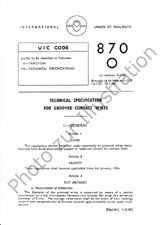Wir benötigen Ihre Einwilligung zur Verwendung der einzelnen Daten, damit Sie unter anderem Informationen zu Ihren Interessen einsehen können. Klicken Sie auf "OK", um Ihre Zustimmung zu erteilen.

UIC HARMOTRACK1-1ed.
Sub Working Group 1 - Determination of acceleration thresholds for track monitoring
Name übersetzen
NORM herausgegeben am 1.5.2025
Informationen über die Norm:
Bezeichnung normen: UIC HARMOTRACK1-1ed.
Ausgabedatum normen: 1.5.2025
SKU: NS-1223765
Zahl der Seiten: 112
Gewicht ca.: 367 g (0.81 Pfund)
Land: Internationale technische Norm
Kategorie: Technische Normen UIC
Die Annotation des Normtextes UIC HARMOTRACK1-1ed. :
The UIC Harmotrack project aims to explore all of the possible uses of dynamic measurements (either acceleration or force) for railway track monitoring. Started in 2019, the project was divided into three sub working groups (SWG) in 2021 once the technical goals had been established. This SWG1 report gives recommendations on acceleration measurement thresholds that accurately relate to the actual safety and comfort standards for track geometry. This is done through analysing the correlation between acceleration measurements and train-track interaction forces on the one hand, and the correlation between acceleration measurements and track geometry measurements on the other. Several approaches have been explored to provide innovative uses for acceleration measurements.Acceleration measurements are usually post-processed using the methods described in the European standards EN 14363 and EN 13848. In this report, new post-processing methods have been explored, aiming especially to eliminate the influence of train speed on measured acceleration. Literature reviews were carried out, dealing with inferring wheel-rail forces from axle-box accelerations, and using machine learning or analytical models.Then, the relationship between track geometry and acceleration parameters (in the bogie and carbody) was modelled through linear and multilinear regressions. Using these regressions and considering existing geometry parameter thresholds, acceleration parameter thresholds can subsequently be computed. Nevertheless, when simulating the detection of threshold exceedances a large quantity of false positives are detected, and is only valid for longitudinal level irregularities. A similar approach using the threshold exceedance rate was tested, but with each parameter being qualified with a risk, and using a risk analysis to identify the relationship between geometry defects and acceleration defects. Moreover, these approaches linking the geometry parameters with acceleration should take the combination of geometry defects into account, as these could trigger a high dynamic response in the train.A machine learning study was also carried out in order to detect track sections with geometry defects, using only acceleration measurements. Again, this approach is more relevant for longitudinal level irregularities. This technical report is the result of the work and collaboration, from 2021 to 2023, between SNCF Réseau (France), SBB CFF FFS (Switzerland), RFI (Italy), FRA/VOLPE (USA), VLI LOGISTICA (Brazil), RATP (France), PKP PLK S.A. (Poland), the Technical University of Munich (Germany), TCDD (Turkey), Network Rail (United Kingdom), National Research Council Canada (Canada), Instytut Kolejnictwa (Poland), the University of Birmingham (United Kingdom), the University of Novi Sad (Serbia), the Polytechnic University of Milan (Italy).The study was carried out under the UICs Harmotrack project with resources and data being provided by the projects members.
Auteur UIC
Nombre de pages 112
ISBN 978-2-7461-3463-8
Empfehlungen:
Aktualisierung der technischen Normen
Wollen Sie sich sicher sein, dass Sie nur die gültigen technischen Normen verwenden?
Wir bieten Ihnen eine Lösung, die Ihnen eine Monatsübersicht über die Aktualität der von Ihnen angewandten Normen sicher stellt.
Brauchen Sie mehr Informationen? Sehen Sie sich diese Seite an.



 Cookies
Cookies
